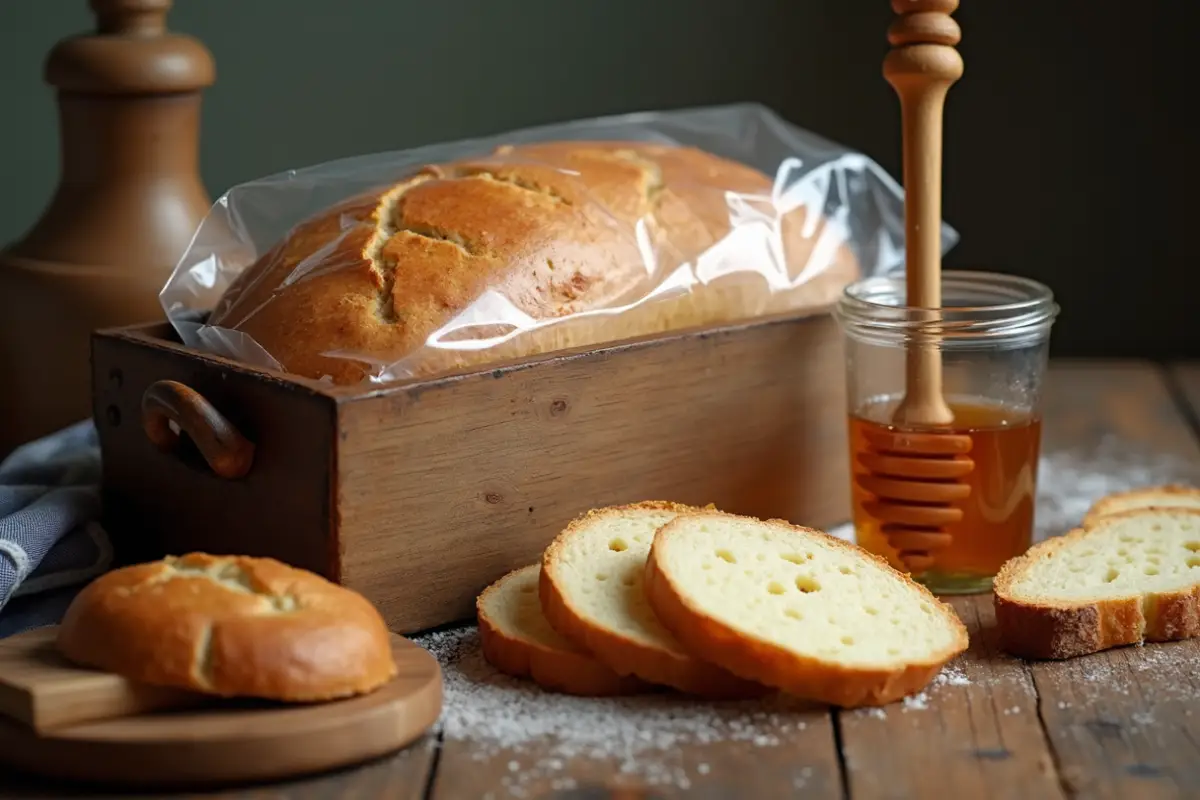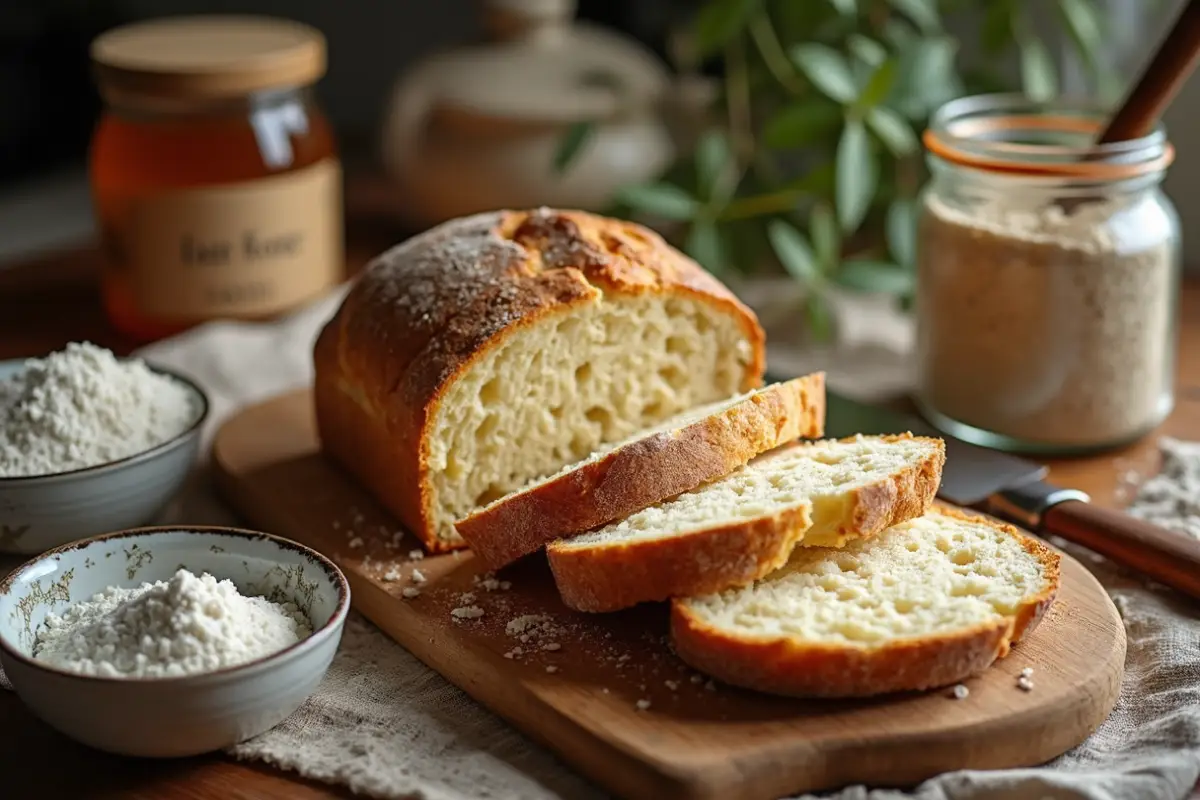Sweet sourdough bread is a delicious and unique variation of the traditional sourdough loaf. Unlike its tangier cousin, this bread offers a delicate sweetness that complements its soft, chewy texture. Sweet sourdough bread recipe is becoming increasingly popular for those who enjoy a twist on their regular bread recipes.
Whether you’re a novice baker or an experienced enthusiast, this recipe provides an excellent opportunity to master the basics of sourdough while incorporating a pleasant sweetness. The natural fermentation process combined with ingredients like honey or sugar results in a lightly sweetened loaf that still retains the signature tang from the sourdough starter. Moreover, this bread can be enjoyed at any time of the day, making it a versatile addition to your baking repertoire.
In this article, we’ll explore how to make this delightful bread, the ingredients required, and the steps to ensure your bread turns out perfectly every time.
Table of Contents

Why Sweet Sourdough Bread is a Delightful Twist on Tradition
Sweet sourdough bread is an exciting departure from the classic sourdough recipe, offering a more complex flavor profile. While traditional sourdough features a distinct tanginess, the addition of sweeteners such as honey or sugar creates a balanced and irresistible loaf. The fermentation process in sourdough bread gives it a natural leavening, which contributes to the lightness of the bread while also enhancing its flavor.
The slight sweetness doesn’t overpower the traditional sourdough taste but adds a new dimension to it. The balance of sweet and sour makes it perfect for a variety of meals, from savory dishes to sweet toppings like butter or jam. Additionally, the crust of sweet sourdough is typically golden and slightly caramelized, providing an extra layer of texture and flavor.
This twist on tradition is ideal for those who want to experiment with their baking or seek a versatile bread for different occasions. Whether served at breakfast, alongside a hearty soup, or as a snack, sweet sourdough is bound to impress.
The Essential Ingredients for Sweet Sourdough Bread
To make the perfect sweet sourdough bread, the right ingredients are key. While the recipe might differ slightly from one baker to another, the following ingredients are essential:
- Sourdough starter – This is the base for any sourdough bread, providing natural yeast for fermentation.
- Flour – High-quality bread flour works best, as it provides the right texture and elasticity for the dough.
- Water – Hydration is crucial for proper fermentation. Filtered water is recommended to avoid unwanted chemicals.
- Sweetener – Depending on your preference, you can use honey, sugar, or maple syrup to give the bread its sweetness. Each adds a unique flavor.
- Salt – A pinch of salt enhances the flavor of the bread and helps control the fermentation process.
- Oil or Butter – Adds richness and tenderness to the bread.
These ingredients are staples in most sourdough recipes, but the addition of a sweetener makes all the difference in creating a soft, delicious loaf.
Step-by-Step Guide to Making Sweet Sourdough Bread

Making sweet sourdough bread requires patience and precision, but the end result is worth every step. Below is a detailed guide to walk you through the process from start to finish.
Preparing the Dough: Key Steps for a Perfect Rise
To start, you’ll need a healthy sourdough starter. Ensure that your starter is active and bubbly before beginning the dough preparation. Here are the steps:
- Mix the Ingredients: In a large bowl, combine the sourdough starter, water, and sweetener. Stir until the sweetener dissolves completely.
- Add Flour and Salt: Gradually add the flour and salt to the wet ingredients. Mix until a sticky dough forms.
- Kneading the Dough: Once the dough is formed, turn it out onto a floured surface. Knead for 8-10 minutes until smooth and elastic. If the dough is too sticky, add a little more flour.
- First Rise: Place the dough in a lightly oiled bowl, cover with a damp towel, and let it rise at room temperature for 4-6 hours, or until it doubles in size. This slow rise allows the dough to develop its signature texture.
Shaping and Baking: Tips for the Perfect Crust and Texture
After the dough has risen, it’s time to shape and bake your sweet sourdough:
- Shape the Dough: Gently punch down the dough to release air bubbles. Shape it into a round or oval loaf, depending on your preference.
- Second Rise: Place the shaped dough onto a baking sheet lined with parchment paper. Cover it and let it rise for another 1-2 hours, or until it puffs up.
- Preheat the Oven: Preheat your oven to 475°F (245°C) with a baking stone or Dutch oven inside for even heat distribution.
- Bake the Bread: Score the top of the dough with a sharp knife or razor blade to allow the bread to expand as it bakes. Bake for 25-30 minutes, or until the crust is golden brown and the loaf sounds hollow when tapped on the bottom.
- Cool: Allow the bread to cool completely on a wire rack before slicing.
Following these steps ensures that your sweet sourdough bread will have the perfect texture, flavor, and crust.
Understanding the Science Behind Sweet Sourdough
Understanding the science of sourdough is essential for achieving the best results. The key component of sourdough bread is its natural fermentation process, which is facilitated by wild yeast and lactic acid bacteria.
- Fermentation: During fermentation, the wild yeast in your starter feeds on the sugars in the dough. This produces carbon dioxide, which makes the dough rise. The lactic acid bacteria also contribute to the tangy flavor of traditional sourdough, and in the case of sweet sourdough, the additional sugars balance out the sourness.
- Hydration: The ratio of water to flour in the dough influences the bread’s texture. More water makes the dough stickier and softer, while less water creates a denser loaf.
- Sweeteners: Adding sweeteners like honey or maple syrup not only enhances the flavor but also aids in the browning of the crust due to the Maillard reaction.
By understanding the underlying science, you can manipulate the ingredients and steps to fine-tune your sweet sourdough bread recipe to perfection.
Variations on Sweet Sourdough: Adding Flavors and Mix-ins
One of the best parts about baking your own sweet sourdough bread is the freedom to experiment with different flavors. Here are a few variations you can try:
- Cinnamon and Raisins: Adding cinnamon and raisins to the dough creates a delightful, sweet twist perfect for breakfast.
- Orange Zest and Almonds: For a more sophisticated flavor, consider mixing in orange zest and toasted almonds.
- Chocolate Chips: If you’re craving something indulgent, chocolate chips provide an extra touch of sweetness and richness to the bread.
Feel free to get creative with your mix-ins, but be sure to maintain the balance of sweet and sour for the best results.
How to Store Your Sweet Sourdough Bread for Maximum Freshness

Proper storage is crucial to keeping your sweet sourdough bread fresh. Without proper care, the bread can dry out or lose its flavor over time. Here are some tips:
Storing Sourdough on the Counter vs. Refrigeration
- Counter: If you plan to eat your bread within a few days, store it on the counter in a paper bag or a bread box. This method allows the bread to breathe, preventing it from becoming too moist.
- Refrigeration: For longer storage, you can refrigerate your sweet sourdough, but it’s best to wrap it in plastic or foil to maintain moisture.
While refrigeration can extend the bread’s shelf life, it may affect the texture slightly. To revive it, simply toast the slices before serving.
Freezing Sweet Sourdough: A Long-Term Storage Solution
If you want to store your bread for a longer period, freezing is a great option. Follow these steps:
- Slice the Bread: It’s easier to defrost slices rather than a whole loaf.
- Wrap the Bread: Wrap each slice or the entire loaf in plastic wrap or foil.
- Freeze: Place the wrapped bread in a freezer-safe bag or container to prevent freezer burn.
To defrost, leave the bread at room temperature or warm it in the oven.
Troubleshooting Common Issues with Sweet Sourdough Bread
Even experienced bakers encounter challenges when making sourdough bread. Here are some common issues and their solutions:
- Dense Texture: If your bread turns out dense, it might be due to insufficient fermentation. Ensure that your dough rises long enough to develop its full flavor.
- Flat Loaf: If your loaf doesn’t rise as expected, check your starter’s activity. It should be bubbly and active before use.
- Overly Sweet or Bland: Adjust the amount of sweetener to balance the flavors. You can also experiment with different types of sweeteners for varied results.
By addressing these issues, you can perfect your sweet sourdough bread recipe.
Health Benefits of Sweet Sourdough Bread and Why It’s a Great Choice
Not only is sweet sourdough bread a delicious treat, but it also offers some health benefits. The natural fermentation process makes sourdough bread easier to digest, as the bacteria help break down gluten. Moreover, sourdough contains beneficial probiotics, which contribute to gut health. The slow fermentation process also lowers the glycemic index of the bread, making it a better option for those looking to manage their blood sugar levels.
Sweet sourdough, while still indulgent, can provide a more balanced alternative to other sweet breads. By using natural sweeteners and avoiding additives, it can be a wholesome option for your daily bread consumption.
A Delicious Breakfast with Sweet Sourdough Bread: Ideas and Pairings
Sweet sourdough bread is a fantastic choice for breakfast. The subtle sweetness of the bread pairs well with a variety of spreads and toppings. Here are some ideas:
- Butter and Jam: Spread a generous layer of butter and top with homemade fruit jam for a simple yet satisfying breakfast.
- Avocado and Egg: For a savory twist, try spreading mashed avocado on toasted sourdough with a soft-boiled egg on top.
- Cinnamon Butter: Combine cinnamon and butter for a quick and flavorful spread that enhances the natural sweetness of the bread.
Whether you prefer sweet or savory, sweet sourdough bread can easily be adapted to suit your breakfast preferences.
For a comforting dinner, try these Slow Cooker Tuscan Chicken Meatballs with Gnocchi and Alfredo Meatballs Recipe.
frequently asked questions :
Can sourdough bread be sweet?
Yes, sourdough bread can be sweet! While traditional sourdough is known for its tangy flavor, you can easily create a sweet variation by adding sweeteners such as sugar, honey, or maple syrup to the dough. These additions balance out the natural sourness, resulting in a more mellow and delightful flavor profile. This sweet sourdough is perfect for a variety of dishes, from breakfast to dessert.
Can I put sugar in my sourdough bread?
Absolutely! You can add sugar to your sourdough bread to create a sweeter taste. Typically, a small amount of sugar or honey is used to give the bread a hint of sweetness without overpowering the sourdough flavor. The sugar helps feed the natural yeast in the starter, which promotes fermentation and aids in the rise of the dough. It’s a great way to make your sourdough more versatile and suitable for different meal occasions.
What happens if I add honey to sourdough bread?
When you add honey to sourdough bread, it imparts a subtle sweetness while enhancing the flavor complexity. Honey also helps the bread rise by feeding the wild yeast in your starter. As it bakes, the honey adds a rich, caramelized sweetness to the crust. Additionally, honey has natural humectant properties, meaning it helps retain moisture in the bread, resulting in a softer, more tender loaf.
When to add cinnamon sugar to sourdough bread?
Cinnamon sugar is typically added to sourdough bread just before baking. After shaping the dough and allowing it to rise for the second time, you can sprinkle the cinnamon sugar mixture on top of the loaf or incorporate it into the dough itself for a more integrated flavor. If you prefer, you can also swirl cinnamon sugar into the dough before the final rise to create a marbled effect that looks as good as it tastes.
What is a good sweet add-in for sourdough bread?
There are plenty of great sweet add-ins you can try for your sourdough bread. Some popular options include:
Dried fruits like raisins, cranberries, or apricots.
Nuts such as walnuts, pecans, or almonds.
Chocolate chips for a more indulgent treat.
Citrus zest like lemon or orange for a fresh, fragrant twist.
Spices such as cinnamon or nutmeg for warmth and depth of flavor.
These add-ins complement the naturally tangy flavor of sourdough and bring a delightful sweetness to every slice. Feel free to experiment and find your favorite combination!
Conclusion: Enjoying Your Homemade Sweet Sourdough Bread
Making and enjoying homemade sweet sourdough bread is a rewarding experience. With the right ingredients, techniques, and patience, you can create a bread that’s both delicious and versatile. Whether you’re serving it for breakfast, as part of a meal, or as a snack, sweet sourdough is sure to impress. So, don’t hesitate to try this recipe and enjoy the delightful twist on traditional sourdough. Your taste buds will thank you!





